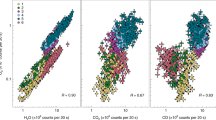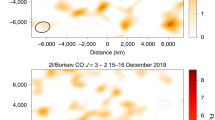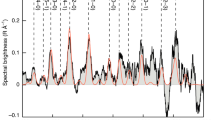Abstract
The composition of the neutral gas comas of most comets is dominated by H2O, CO and CO2, typically comprising as much as 95 per cent of the total gas density1. In addition, cometary comas have been found to contain a rich array of other molecules, including sulfuric compounds and complex hydrocarbons. Molecular oxygen (O2), however, despite its detection on other icy bodies such as the moons of Jupiter and Saturn2,3, has remained undetected in cometary comas. Here we report in situ measurement of O2 in the coma of comet 67P/Churyumov–Gerasimenko, with local abundances ranging from one per cent to ten per cent relative to H2O and with a mean value of 3.80 ± 0.85 per cent. Our observations indicate that the O2/H2O ratio is isotropic in the coma and does not change systematically with heliocentric distance. This suggests that primordial O2 was incorporated into the nucleus during the comet’s formation, which is unexpected given the low upper limits from remote sensing observations4. Current Solar System formation models do not predict conditions that would allow this to occur.
This is a preview of subscription content, access via your institution
Access options
Subscribe to this journal
Receive 51 print issues and online access
$199.00 per year
only $3.90 per issue
Buy this article
- Purchase on Springer Link
- Instant access to full article PDF
Prices may be subject to local taxes which are calculated during checkout




Similar content being viewed by others
References
Bockelée-Morvan, D., Mumma, M. J. & Weaver, H. A. in Comets II (eds Festou, M., Keller, U. H. & Weaver, H. A. ) 391–423 (Univ. Arizona Press, 2004)
Hall, D. T., Strobel, D. F., Feldman, P. D., McGarth, M. A. & Weaver, H. A. Detection of an oxygen atmosphere on Jupiter’s moon Europa. Nature 373, 677–679 (1995)
Johnson, R. E. et al. Production, ionization and redistribution of O2 in Saturn’s ring atmosphere. Icarus 180, 393–402 (2006)
Goldsmith, P. F. et al. Herschel measurements of molecular oxygen in Orion. Astrophys. J. 737, 96 (2011)
Balsiger, H. et al. ROSINA — ROSETTA orbiter spectrometer for ion and neutral analysis. Space Sci. Rev. 128, 745–801 (2007)
Hässig, M. et al. Time variability and heterogeneity in the coma of 67P/Churyumov-Gerasimenko. Science 347, aaa0276 (2015)
Luspay-Kuti, A. et al. Composition-dependent outgassing of comet 67P/Churyumov-Gerasimenko from ROSINA/DFMS — implications for nucleus heterogeneity? Astron. Astrophys. http://dx.doi.org/10.1051/0004-6361/201526205 (2015)
De Sanctis, M. C. et al. The diurnal cycle of water ice on comet 67P/Churyumov–Gerasimenko. Nature 525, 500–503 (2015)
Capaccioni, F. et al. The organic-rich surface of comet 67P/Churyumov-Gerasimenko as seen by VIRTIS/Rosetta. Science 347, aaa0628 (2015)
Brown, W. L. et al. Erosion and molecular formation in condensed gas films by electronic energy loss of fast ions. Nucl. Instrum. Methods 198, 1–8 (1982)
Carlson, R. W. et al. Hydrogen peroxide on the surface of Europa. Science 283, 2062–2064 (1999)
Spencer, J. R., Calvin, W. M. & Person, M. J. Charge-coupled device spectra of the Galilean satellites: molecular oxygen on Ganymede. J. Geophys. Res. 100, 19049–19056 (1995)
Spencer, J. R. & Calvin, W. M. Condensed O2 on Europa and Callisto. Astron. J. 124, 3400–3403 (2002)
Vandenbussche, B. et al. Constraints on the abundance of solid O2 in dense clouds from ISO-SWS and ground-based observations. Astron. Astrophys. 346, L57–L60 (1999)
Pontoppidan, K. et al. A 3–5 μm VLT spectroscopic survey of embedded young low mass stars I. Structure of the CO ice. Astron. Astrophys. 408, 981–1007 (2003)
Liseau, R. et al. Multi-line detection of O2 toward ρ Ophiuchi A. Astron. Astrophys. 541, A73 (2012)
Larsson, B. et al. Molecular oxygen in the Ophiuchi cloud. Astron. Astrophys. 466, 999–1003 (2007)
Yıldız, U. A. et al. Deep observations of O2 toward a low-mass protostar with Herschel-HIFI. Astron. Astrophys. 558, A58 (2013)
Taquet, V., Ceccarelli, C. & Kahane, C. Multilayer modeling of porous grain surface chemistry. I. The GRAINOBLE model. Astron. Astrophys. 538, A42 (2012)
Bergman, P. et al. Detection of interstellar hydrogen peroxide. Astron. Astrophys. 531, L8 (2011)
Parise, B., Bergman, P. & Du, F. Detection of the hydroperoxyl radical HO2 toward ρ Ophiuchi A. Additional constraints on the water chemical network. Astron. Astrophys. 541, L11 (2012)
Du, F., Parise, B. & Bergman, P. Production of interstellar hydrogen peroxide (H2O2) on the surface of dust grains. Astron. Astrophys. 538, A91 (2012)
Rubin, M. et al. Molecular nitrogen in comet 67P/Churyumov-Gerasimenko indicates a low formation temperature. Science 348, 232–235 (2015)
Walsh, C., Nomura, H. & van Dishoeck, E. The molecular composition of the planet-forming regions of protoplanetary disks across the luminosity range. Astron. Astrophys. 582, A88 (2015)
Johnson, R. E. & Jesser, W. A. O2/O3 microatmospheres in the surface of Ganymede. Astrophys. J. 480, L79–L82 (1997)
Cleeves, L. I. et al. The ancient heritage of water ice in the solar system. Science 345, 1590–1593 (2014)
Altwegg, K. et al. 67P/Churyumov-Gerasimenko, a Jupiter family comet with a high D/H ratio. Science 347, http://dx.doi.org/10.1126/science.1261952 (2015)
Schläppi, B. et al. Influence of spacecraft outgassing on the exploration of tenuous atmospheres with in situ mass spectrometry. J. Geophys. Res. 115, A12313 (2010)
Tian, C. & Vidal, C. R. Electron impact dissociative ionization of CO2: measurements with a focusing time-of-flight mass spectrometer. J. Chem. Phys. 108, 927 (1998)
Fuselier, S. A. et al. ROSINA/DFMS and IES observations of 67P: ion-neutral chemistry in the coma of a weakly outgassing comet. Astron. Astrophys http://dx.doi.org/10.1051/0004-6361/201526210 (2015)
Zheng, W., Jewitt, D. & Kaiser, R. I. Formation of hydrogen, oxygen and hydrogen peroxide in electron-irradiated crystalline water ice. Astrophys. J. 639, 534–548 (2006)
Cooper, J. F., Christian, E. R. & Johnson, R. E. Heliospheric cosmic ray irradiation of Kuiper belt comets. Adv. Space Res. 21, 1611–1614 (1998)
Grieves, G. A. & Orlando, T. M. The importance of pores in the electron stimulated production of D2 and O2 in low temperature ice. Surf. Sci. 593, 180–186 (2005)
Maquet, L. The recent dynamical history of comet 67P/Churyumov-Gerasimenko. Astron. Astrophys. 579, A78 (2015)
Wurz, P. et al. Solar wind sputtering of dust on the surface of 67P/Churyumov-Gerasimenko. Astron. Astrophys http://dx.doi.org/10.1051/0004-6361/201525980 (2015)
Acknowledgements
Work at the University of Michigan was funded by NASA contract JPL-1266313. Work at the University of Bern was funded by the State of Bern, the Swiss National Science Foundation and the European Space Agency PRODEX Program. Work at Max-Planck-Institut für Sonnensystemforschung was funded by the Max-Planck Society and BMWI contract 50QP1302. Work at Southwest Research Institute was supported by subcontract 1496541 from the Jet Propulsion Laboratory. Work at BIRA-IASB was supported by the Belgian Science Policy Office via PRODEX/ROSINA PEA 90020. This work was carried out thanks to the support of the A*MIDEX project (no. ANR-11-IDEX-0001-02) funded by the ‘Investissements d’Avenir’ French Government programme, managed by the French National Research Agency (ANR). This work was supported by CNES grants at IRAP, LATMOS, LPC2E, UTINAM, CRPG, and by the European Research Council (grant no. 267255 to B.M.). A.B.-N. thanks the Ministry of Science and the Israel Space agency. Work by J.H.W. at Southwest Research Institute was funded by NASA JPL subcontract NAS703001TONMO710889. E.F.v.D. and C.W. are supported by A-ERC grant 291141 CHEMPLAN and an NWO Veni award. We acknowledge here the work of the whole ESA Rosetta team.
Author information
Authors and Affiliations
Contributions
A.B. performed data reduction, analysis and wrote the paper; K.A. initialized and edited the paper and contributed to data interpretation; C.B., U.C., M.C., T.I.G., K.C.H., S.G., M.H., A.J., R.M., L.L.R., M.R., C.-Y.T. and T.S. contributed to data analysis and interpretation. A.B.-N. and O.M. contributed to data interpretation relevant to processes in ices. E.F.v.D and C.W. contributed to data interpretation and writing of sections concerning interstellar oxygen. H.B., J.-J.B., P.B., J.D.K., B.F., S.A.F., A.K., U.M., B.M., T.O., H.R., J.H.W. and P.W. contributed to experiment design, calibration and data interpretation. All authors discussed the results, and commented on and revised the manuscript.
Corresponding author
Ethics declarations
Competing interests
The authors declare no competing financial interests.
Additional information
All ROSINA-DFMS data will be released to the PSA archive of ESA and to the PDS archive of NASA.
Rights and permissions
About this article
Cite this article
Bieler, A., Altwegg, K., Balsiger, H. et al. Abundant molecular oxygen in the coma of comet 67P/Churyumov–Gerasimenko. Nature 526, 678–681 (2015). https://doi.org/10.1038/nature15707
Received:
Accepted:
Published:
Issue Date:
DOI: https://doi.org/10.1038/nature15707
This article is cited by
-
The Comet Interceptor Mission
Space Science Reviews (2024)
-
Underground reservoir of oxygen in comet 67P
Nature Astronomy (2022)
-
Dual storage and release of molecular oxygen in comet 67P/Churyumov–Gerasimenko
Nature Astronomy (2022)
-
The search for living worlds and the connection to our cosmic origins
Experimental Astronomy (2022)
-
UV exploration of the solar system
Experimental Astronomy (2022)
Comments
By submitting a comment you agree to abide by our Terms and Community Guidelines. If you find something abusive or that does not comply with our terms or guidelines please flag it as inappropriate.



